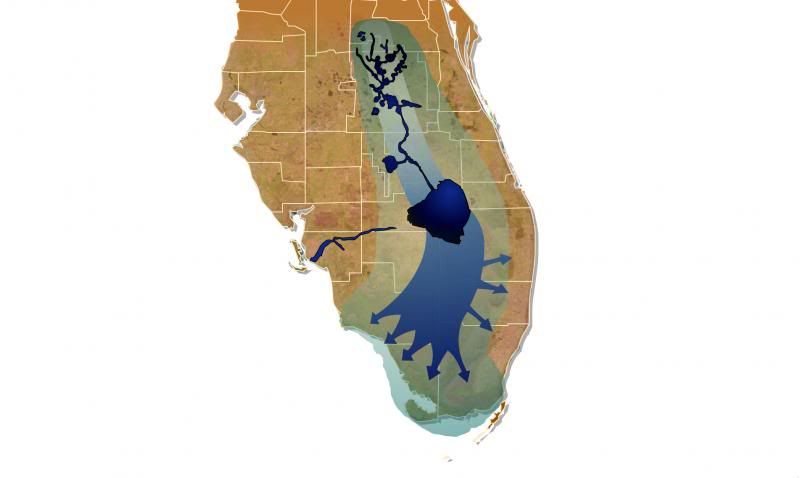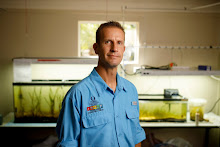1. High volume freshwater discharges from Lake Okeechobee to the Caloosahatchee Estuary, leading to reduced salinity, murky water, and harm to seagrasses, oysters, fish, and tourism.
2. High volume freshwater discharges from Lake Okeechobee to the St. Lucie Estuary, leading to reduced salinity, murky water, and harm to seagrasses, oysters, nearshore reefs, fish, and tourism.
3. Death of seagrasses and reefs in the Florida Bay / Florida Keys region, related to disruption of normal freshwater flow from the Everglades wetland system.
Concurrently, harmful algal blooms, including red tide, brown tide, blue-green algae, and seaweed blooms, have increased throughout Florida estuaries and coastal oceans. These "HAB"s have negative effects ranging from simply creating unsightly murky water, to killing seagrasses, corals, fish and marine mammals, to creating oxygen-depleted "dead zones", to even sickening humans who walk on the beach.
All of these problems are strongly related to the "altered hydrology" of South Florida. Hydrology is how freshwater makes its way from the land to the ocean. Historically, the hydrology of South Florida was a slow flow through forests, swamps, lazy rivers, groundwater springs, and wetlands like the Everglades.
Historic, diffuse pattern of freshwater flow across South Florida. Note that there was no link between Lake Okeechobee and the estuaries on the West and East Coasts of the State. The flow just went overland to the Everglades in the South.

The land was covered in vegetation, which filtered out the dirt from the water and sucked up most of the water-borne nutrients (chemicals like Nitrogen and Phosphorus) before they could reach the coasts. (Though nutrients occur naturally and are essential for plant life, excessive flux of nutrients into waterways, due to man-made sources like fertilizer and sewage, and due to loss of natural filters like wetlands, causes HABs and all their nasty effects.) So the coastal waters were cleaner and clearer than they are now.
In addition to the dirt- and nutrient-removal benefits of a diffuse, slow-flowing hydrology, the old Florida flow pattern also evened out the effects of droughts and heavy rains on the amount of water flowing into estuaries. (An estuary is a bay where freshwater flowing off the land mixes with saltwater from the ocean.) The freshwater flows levels were evened out because wetlands like the Everglades would naturally store water during wet times and leach out water during dry times. A relatively consistent, moderate amount of freshwater entering an estuary allows abundant and diverse life to flourish, whereas "all or nothing" freshwater flows create extreme too-fresh/too-salty conditions that most life cannot tolerate.
You might be asking, "If the natural hydrology of South Florida was so wonderful, why did people alter it?" Well, the alterations began a long time ago (in the 1800s and early 1900s) before many people realized how important the natural pattern was. At the time we thought wetlands like the everglades were just useless land, too wet to farm or build on. So various private and government groups dug deep, straight canals to hasten the flow of water off the land. This effectively turned the wetlands into dry lands, but it eliminated the land's ability to store and filter water. So the estuaries were subjected to extreme high and low flows of freshwater, and the water was also dirtier than before.
Additional hydrologic changes were made when it was realized that the drainage canals actually worked too well, and farming was being disrupted by dry peaty soils blowing away or even catching on fire. So expensive dams, locks, and pumps were added to the canals to retain water for agriculture sometimes, and drain water off the land at other times. That further increased the variability in how much freshwater made it into the estuaries, so the environmental conditions in the estuaries got really weird and bad. The most famous/infamous man-made hydrologic change was the interruption of the southward flow of the Everglades. The everglades, aka the "river of grass," historically flowed from the soggy south banks of Lake Okeechobee through endless kilometers of sawgrass, down to the "10,000 islands" region where it blended into "Florida Bay," the vast expanse of shallow water between mainland South Florida and the islands and reefs of the Florida Keys. Along the way, the everglades flow recharged groundwater sources really important for the growing human population of Southeast Florida (Palm Beach to Miami).
Anyway, in order to control flooding and expand farming in the everglades-origin area on the south shores of Lake Okeechobee, a big dike was built to prevent the lake from overflowing to the South, and lots of drainage canals, locks, and pumping stations were built to dry out the land there and create a massive "Everglades Agricultural Area" (EAA) where un-farmable wetlands used to be. The main crop in the EAA now is sugarcane. To deal with the excess water buildup in Lake Okeechobee, since it could no longer flow southward without flooding sugarcane fields, giant canals were built on the east and west sides of Lake Okeechobee to drain its water into the Atlantic Ocean and the Gulf of Mexico, respectively. The receiving estuary for the westward Okeechobee purges is the Caloosahatchee Estuary. The receiving estuary for the eastward Okeechobee purges is the St. Lucie Estuary. Hence, disasters #1 and #2, above. Disaster #3 in Florida Bay is caused by insufficient freshwater delivery to Florida Bay, which creates super salty conditions fatal to seagrass and coral.
This video explains the problem pretty well.
So, what's the solution? The Comprehensive Everglades Restoration Plan, a joint effort of state government (the South Florida Water Management District) and federal government (the US Army Corps of Engineers) aims to restore more natural patterns of flow, somewhat ironically, by more digging, damming, and pumping. There are many different CERP projects scattered all over South Florida, ranging widely in size, cost, and stage of planning/completion. CERP has had some successes, notably the restoration of natural river bends and wetlands around the Kissimmee River on the north side of Lake Okeechobee. Another interesting CERP project, the "C43 Reservoir," is underway along the shore of the Caloosahatchee River. For that project, low-lying farm fields are being dug up and turned into a water storage area that will be filled when water flows are high and gradually drained when water flows are low, to reduce the extremes of high and low flows reaching the Caloosahatchee Estuary. Some CERP funding also goes to support environmental monitoring and research in the areas where habitats, water quality, and wildlife are affected by the altered hydrology. For example, I have received funding from CERP to support my studies of the effects of Lake Okeechobee releases on seagrasses in the Caloosahatchee Estuary. You can read my 2014 report by clicking here, then clicking "Caloosahatchee Estuary," then clicking the "SAV" tab.
Unfortunately, the CERP projects completed or underway so far won't do enough to stop the big 3 problems. The centerpiece of the CERP plan, which has yet to be enacted, would do a lot more. The centerpiece would be the buyout of a huge swath of the EAA (the sugar land) south of Lake Okeechobee. The buyout would allow the South Florida Water Management District and the US Army Corps of Engineers to create a giant semi-natural wetland that would convey a significant volume of Lake Okeechobee water into the Everglades, filtering out some of the pollution in the water along the way. The Florida public, and the SFWMD and USACOE scientists with whom I regularly interact, are overwhelmingly in support of the buyout plan. It just makes sense. So far, the elected officials who have the power to enact the buyout have neglected to do so. Perhaps that will change as the increasingly obvious signs of environmental degradation spur public activism. Some of the activist groups already vocal on these issues are:
Captains for Clean Water
Save our Estuaries
Caloosahatchee River Watch
Sanibel Captiva Conservation Foundation
Conservancy of South West Florida
Though the motivations of the different activist groups are varied, from protecting nature to enhancing fishing to increasing tourism, it's interesting that they all seem to be coalescing around one central message: "Buy the land, send the water south."

2 comments:
I appreciated reading your historical depiction about the nps issues regarding Everglades and Estuary Crises in South Florida. I am a retired Soil Conservationist, former resident along eastern coast do Florida, moved to Jersey Shore, my dad was a Navy Vet. I have been following posts and have been reading about "restoration" plans, I put this in quotes only because I have not read anything about efforts to restore, build, or sustain soil functions within the contributing drainage areas. Much discussion about canals, dams..etc. however no assessment of how changing land uses both ag and urban have permanently altered hydrologic conditions through impairment of physical, biological and chemical soil conditions. I have observed and measures both infiltration rates and soil bulk density rates in coastal plain soils. And as you know there is significant differences in natural vs. disturbed soils. I am not fully aware of plans, approaches and ongoing assessments, but if this has not been addressed I would urge planners to investigate published studies regarding such. If you would like I can email somethings we worked on and published along with reports from UF, USDA and others.
David Friedman
djfriedman72@gmail.com
Hi David- You're right. Soils are very important but certainly not the first thing one hears about in the everglades restoration discussions. However, I think there HAS been some soil research as part of CERP. Have you looked through CERP's "Everglades Restoration" website to see if you can find reports on soil conditions or soil restoration efforts? http://www.evergladesrestoration.gov/ Lots of detailed progress reports there, which aren't necessarily publicized. -James
Post a Comment